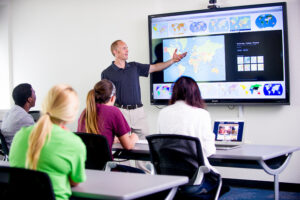The integration of Audio-Visual (AV) technology into classrooms has revolutionized conventional teaching methods in the constantly changing field of education. Teachers no longer rely solely on traditional teaching methods such as chalkboards and static textbooks. Instead, they utilize a wide range of dynamic resources to create interactive and captivating learning environments. This blog post delves into the diverse effects of AV technology, charting its development and analyzing its impact on education. AV technology is revolutionizing education in the digital era, by offering customized instruction and facilitating worldwide cooperation.

The incorporation of audiovisual (AV) technology in education has made significant progress, evolving from the use of projectors in its initial stages to the present era characterized by the prevalence of interactive whiteboards, virtual simulations, and educational applications. The transformative journey signifies the growing necessity to adjust to the changing expectations of students and the wider technological environment. In the present day, the use of smartphones and the implementation of Bring Your Own Device (BYOD) rules contribute to the rapid incorporation of AV technology, offering both opportunities and challenges.
Neil Postman’s analysis of “Sesame Street” offers a stimulating perspective to explore the changes in conventional education brought forth by audiovisual technologies. As we explore the significant consequences of AV breakthroughs, we must contemplate if pupils already anticipate education to emulate the engaging and tailored experiences depicted in media-driven platforms such as “Sesame Street.”
The introduction of AV technology has not only brought forth a new era of captivating material, but also facilitated the development of tailored learning experiences. Educational platforms such as Khan Academy, Coursera, Udemy, and YouTube Education Channels like Crash Course, TED-Ed, etc. provide specialized content, enabling students to advance at their own speed. Nevertheless, the difficulty is in achieving a harmonious equilibrium between individualized guidance and the significance of a collective educational encounter, while also preventing potential feelings of isolation among pupils.
The classroom presentation offers a distinct opportunity to contemplate how students perceive and engage with audiovisual technologies in the realm of education. Do they perceive traditional schooling from the perspective of providing engaging and tailored experiences? The direct experience provided by this perspective contributes a crucial element to the continuing discussion over the influence of AV technology on education.
In a world continually shaped by technological advancements, AV technologies serve as catalysts for educational transformation. The approach enhances student engagement, fosters active participation, and promotes personalized learning experiences. Real-time feedback and the visual representation of complex concepts contribute to improved knowledge retention. The integration of AV technology in traditional classrooms ultimately equips students with the necessary skills for continuous learning and achievement in our interconnected world of digital advancements.
Hey Jashan
Your blog post expertly explores the transformative impact of audio-visual (AV) technologies on education, highlighting the evolution from traditional methods to the current digital era. The nuanced consideration of Neil Postman’s analysis of “Sesame Street” adds depth to the examination, questioning whether students now expect education to mirror media-driven platforms. The balance between individualized learning experiences and the importance of collective educational encounters is thoughtfully addressed, acknowledging the challenges of maintaining cohesion and preventing potential student isolation. Your conclusion effectively underscores the positive influence of AV technologies on student engagement, active participation, and long-term skills development, affirming their crucial role in the evolving landscape of education.
Your post talks about how technology like videos and interactive tools are changing how we learn in classrooms. You mention how things have evolved from old methods like projectors to modern platforms like Khan Academy. You also bring up a smart point about how kids might expect school to be as fun as their favorite TV shows. Overall, you’re saying that using technology in classrooms makes learning more exciting and helps students learn better. It’s a great explanation of how things are changing in education!
Hi jashendeep,
I’m thoroughly impressed by the comprehensive exploration of audiovisual (AV) technology’s transformative impact on education in this blog post. The journey from traditional teaching methods to the dynamic, interactive learning environments facilitated by AV tools is truly remarkable. The analysis of Neil Postman’s insights on “Sesame Street” adds depth to the discussion, prompting critical reflections on the evolving expectations of students in today’s digital age. Furthermore, the emphasis on achieving a balance between tailored learning experiences and collective educational encounters resonates deeply with the challenges educators face. Overall, this piece highlights the immense potential of AV technologies in shaping the future of education.
Thanks for sharing this and I personally agree to what you have mentioned because I am a highly visual and sound person. I understand when I can see and hear simultaneously and It is said majority of us are hight AV in our approach. So it surely works!!